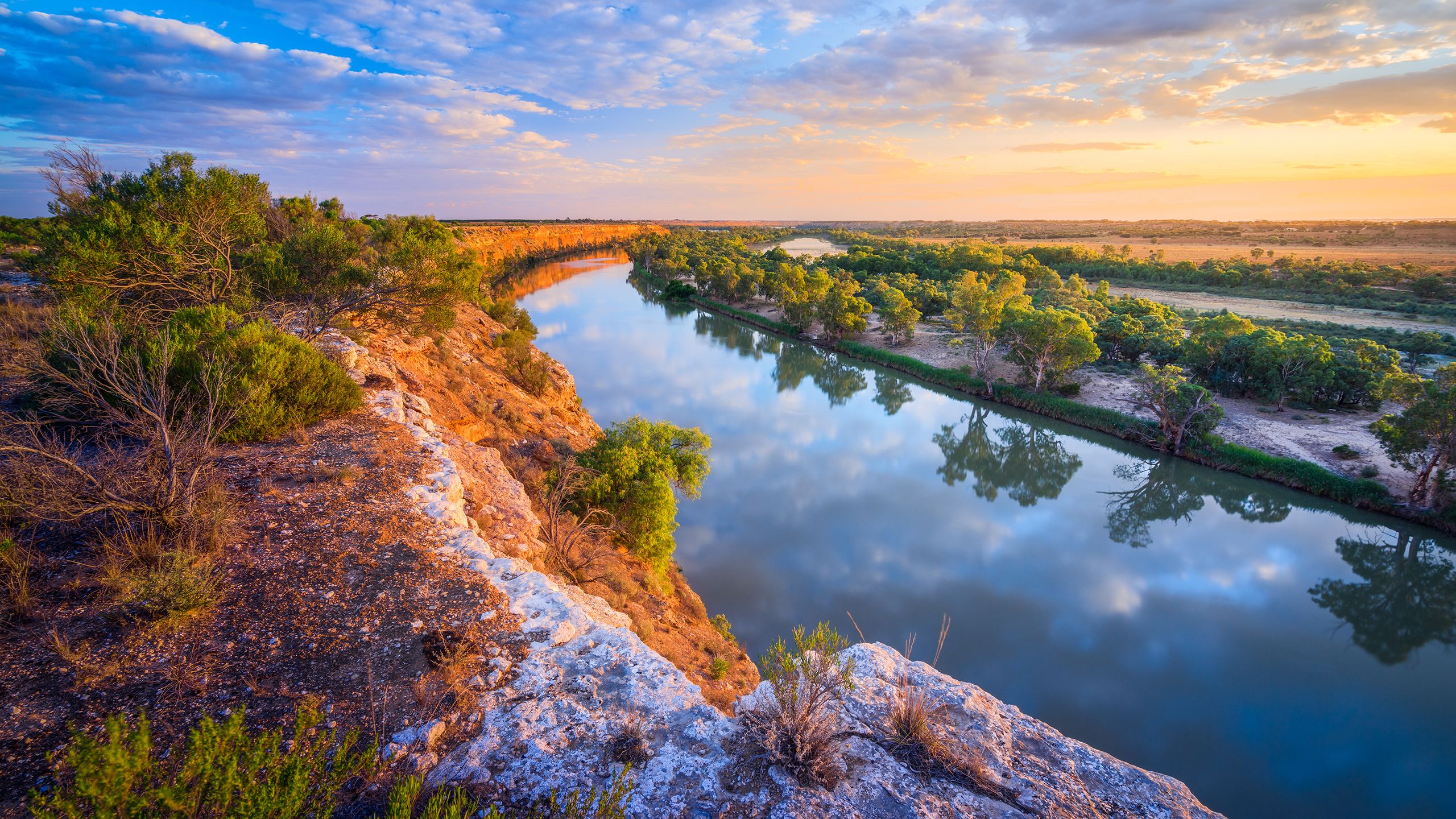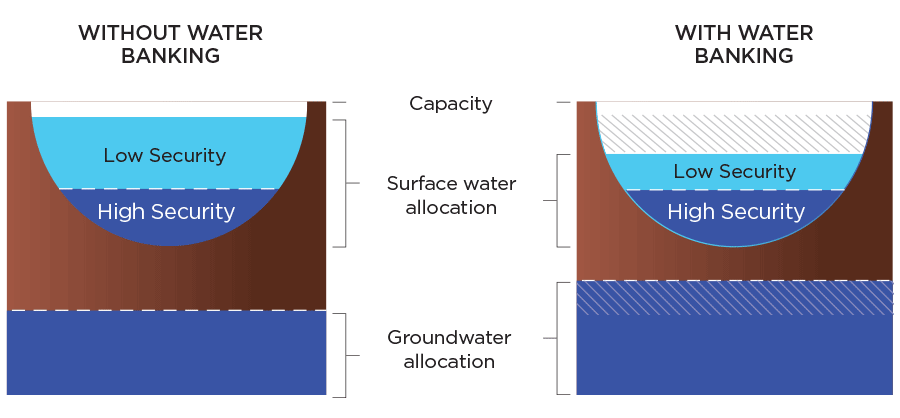Water Banking for Drought Resilience

Despite the heavy rains in many parts of Australia recently, another drought is just around the corner. Water banking is a tool that could improve Australia’s drought preparedness and resilience for the future. But first there are some policy barriers to overcome, which could be easily achieved using pioneering demonstration schemes prior to wider adoption.
Southern Australia is experiencing a widespread drying trend and has recently experienced several harsh droughts. While droughts are a natural part of Australia’s seasonal cycles, they are predicted to become more severe and frequent.1 Considering this, Australia needs new options to improve regional water security.
In the 2020 drought, the Queensland towns of Stanthorpe and Clifton both reached day zero and ran out of water. Another fifty other regional communities across NSW and Queensland had less than twelve months of water left. Costs of emergency water carting would likely exceed $1 million per day for larger regional communities.2
Drought impacts tend to be most felt in Australia’s regional communities where they have a disproportional impact on agricultural industries. With one in seven Australian jobs dependent on farming, the economy relies heavily on agriculture. Drought has been shown to significantly reduce agricultural profitability and productivity. The total value of national welfare lost in the 2019–2020 drought has been estimated to exceed $63 billion.3
Irrigation water allocation prices have also skyrocketed during past droughts before declining to a small fraction of these high prices following the 2011, 2012 and 2017 floods.4
Perennial plantings (e.g. almonds, citrus) are at particular risk if growers cannot afford to purchase water during droughts. Building resilience into these agricultural systems requires new water management tools. One promising approach is water banking.
Why water banking?
Water banking requires investment in infrastructure to realise its benefits. Just as dams are infrastructure required to store water in reservoirs, infiltration basins (Figure 1) are infrastructure to recharge surface water to a suitable aquifer where it can be stored.
The principle of water banking is simple – the existing surface water right holders can forgo using some of their water allocation in a wet year, and instead, voluntarily transfer their allocation to a water bank. The unused water allocations are deposited into an aquifer allowing for the allocation to be carried over to future years. These carried over allocations (or recharge credits) can then be recovered as groundwater allocations later. Water banking is like an underground off-stream dam with the advantage of minimal evaporation and can be used in regions where carryover in surface water dams is currently limited, like the northern Murray-Darling Basin. The higher value horticultural industries have not been established in these regions to date due to water security risks. To establish water banking in these areas, investment in infrastructure such as recharge basins and recovery wells and monitoring will be required to further develop water accounting policy and methodologies.

Figure 1. Infiltration basins during recharge of the Arizona Water Banking Authority. They remain dry at other times as water is stored in the underlying aquifer. Image: Central Arizona Project
Figure 1. Infiltration basins during recharge of the Arizona Water Banking Authority. They remain dry at other times as water is stored in the underlying aquifer. Image: Central Arizona Project
It is estimated that in the Murray-Darling Basin between 2,000 to 4,000 gigalitres of additional aquifer storage potential could be utilised for water banking.5 This is equivalent to 16% of the total accessible surface water storage, meaning no new dams would need to be built.
This aquifer storage exists in the northern basin where there is limited opportunity to carry over allocations across years. Importantly, water banking uses the existing water management framework and extends the carryover provisions for dams in the southern basin to wider areas than is currently available. Water banking is an unexplored tool for investing in water security in the northern basin and is potentially more efficient than flood plain harvesting and farm dams.
Currently there are no policies to prevent appropriate recharge, but there are no policies to assure banked water can be withdrawn when needed. Hence there is no incentive to bank water as a drought mitigating strategy. Policy reform is needed to realise the benefits of water banking.
Consideration of the issues
Policy context
In 2004, the then Council of Australian Governments (COAG) endorsed the National Water Initiative (NWI). The NWI is a shared commitment by governments to increase the efficiency of Australia’s water use, enable equitable sharing among urban and rural communities, and restore the environment. The NWI built upon the 1994 COAG Water Reform Framework and governments committed to prepare comprehensive water plans; achieve sustainable water use in over-allocated basins; introduce registers of water rights and standards for water accounting; expand trade in water rights; improve pricing for water storage and delivery; and better manage urban water demands.
In May 2019, in response to the Productivity Commission’s 2017 inquiry into national water reform,6 the Australian Government agreed to renew the NWI. Previous adoption of water planning and entitlement frameworks had created the foundations for efficient and sustainable water resource management. Water planning had established transparent processes for determining how much water is available in a system and for sharing between people, industry, and the environment. Creation of water entitlements, separate from land, provided secure long-term property rights to water for both consumptive users and the environment. And together, these developments provided the essential prerequisites for the current water trading and water markets.
Water trading and markets have become increasingly important to irrigators to adapt to seasonal variability and climate change. It is now necessary to consider the addition of policies to allow the use of aquifers to provide secure long-term carryover of banked surface waters from existing unused allocations. This builds on the existing framework and decades of water markets and trading experience to provide new opportunities to develop drought resilience.
International lessons
In the United States, there are numerous examples of water banks working to reduce drought effects. For example, Arvin Edison Water Bank in California has been operated by the local water district since the 1960s. Over a 20-year period that spanned two small droughts, it banked 1,100 gigalitres by recharging a depleted aquifer through infiltration basins.7 During drought periods the bank recovered from 100 to 190 gigalitres per year of recharged groundwater to support local irrigators.
Similarly, the Arizona Water Banking Authority established by the government of Arizona can draw upon their 4,378 gigalitres of water stored.8 The Arizona Water Banking Authority has been able to rely upon this water to support indigenous water rights, urban water supplies, and irrigation, and is expected to withdraw a further 82 gigalitres per year as the current drought continues. The water management framework for this is discussed by Megdal et al. (2014).9 These established water banks have proved extremely valuable to communities, irrigators, and the environment during a drought, such as the one currently affecting many parts of the southwest United States, which has led to visibly dry vegetation, increased wildfires, and lower water levels in lakes and reservoirs.
Principal options for Australian policy makers
A similar water management framework for water banking in Australia has been proposed by Ward and Dillon (2012).10 These ideas, while not new, have yet to gain traction in Australia. With the continuing drying climate, new water management tools are needed to manage increasing effects of drought. The following policy reform should be considered to realise the benefits of water banking.
Incentives to invest in water security
The incentives for water banking have already been demonstrated by significant increases in water trading prices during dry periods. For example, the average water price across the southern Murray‑Darling during the 2019–20 drought was $587 per megalitre, compared to the recent price of $154 per megalitre in 2020–2021.11 By having the option to carryover unused water allocations across years in dams, irrigators in the southern basin can create a strategic reserve for themselves to buffer market volatility, all within the existing water management framework. Irrigators in the northern basin are currently more limited in their carryover options.
Irrigators with existing water entitlements would carryover unused water allocations in a similar way to surface water storage carryover in dams. This represents the capacity of water that can be stored and is limited by the specific aquifer characteristics. Each water allocation that was banked would then be recoverable during drought, determined by the volume of water allocation banked subject to depreciation. With policy reform, recharge using lower security surface water allocations during a wet year to a water bank will allow additional carryover and conversion to higher security groundwater allocations in a dry year (Figure 2).
It will be essential to develop clearly defined rights for irrigators to recover a high security groundwater allocation during drought, with guarantees to access and use of the recharged volume. This would have the effect of giving another storage and carryover tool (particularly where there are no dams), but would need to demonstrate that there were no third-party impacts to existing users or the environment.

Figure 2. Conversion of low security surface water to higher security groundwater allocations through water banking.
Figure 2. Conversion of low security surface water to higher security groundwater allocations through water banking.
Establishment, funding, and operations
Water banking in aquifers complements dams by allowing for additional carryover across years. However, aquifer storage has several distinct advantages over dams, including natural treatment, and minimal evaporation loss, algae, and mosquitoes. Pioneering water banking demonstration projects are needed that are well designed, monitored, and managed to provide evidence and confidence that water banking can be effective; has no third-party impacts; sustains the environment; and creates a basin-wide economic benefit. Demonstration projects are important for gaining experience in operation and in governance, community acceptance, and in communicating broadly on performance, costs, and impacts.
In operating a water bank, three components are needed:
- Source water – allocations of water to be recharged already exist. Policy to determine volumes available also already exists.
- Recharge – the infrastructure to recharge water into an aquifer does not yet exist but is simple to construct. The policies to limit adverse impacts on third parties or the environment, including land salinisation and waterlogging, already exist.12
- Recovery – the infrastructure to recover the banked water from an aquifer does not yet exist but is simple to construct, and any additional energy required for pumping in water banking should be sourced from green energy. The policies to provide carryover of water in water banks do not yet exist. This is the crucial policy element that would encourage investment in water banking infrastructure and water allocations to be carried over within water banks.
Additional policy rules would require characterisation of aquifers to prevent localised decline of groundwater levels, water quality deterioration, and interference between any nearby water banking schemes.
Carryover and transfers between surface water flows and groundwater storage
Carryover is used to enable a deferred allocation, subject to local rules. It reflects the opportunity to build future water security by foregoing current use of water and retaining that water in storage. Not using water does not necessarily mean all of it will be physically available for future water use (for example, due to loss by evaporation, or spill from a reservoir, or mixing with saline water or groundwater discharge for an aquifer). These losses can be minimised through scientific site selection for water bank operations and verified by monitoring.
Water banking accounts would need to be kept for recharge and recovery volumes and depreciation, with periodic calculation of residual accrued groundwater allocations. Depreciation of these credits should occur because of finite retention time of water in the aquifer and loss (for example, through mixing with brackish groundwater), but not by declining groundwater storage (where excess of other licensed extraction over natural recharge should not diminish credits of those who have actively banked water).
This will result in the conjunctive management of water resources, enabling users to take from the cheapest source and use this to reduce uncertainty over current allocations while sustaining groundwater storages at levels that will enable buffering during droughts.
Stakeholder consultation
I undertook my Churchill Fellowship in 2010 to assess natural treatment systems for Australian applications in water supply and water recycling.13 My focus shifted over the past ten years, from natural systems used for water treatment, to natural systems such as aquifers and water banking for drought resilience. Over the past decade I have had preliminary consultations to further explore water banking opportunities in Australia.
These include with federal government departments, organisations including the Murray-Darling Basin Authority, National Water Grid Authority, state government water agencies, local governments, and the irrigated agricultural industry. There has been strong interest in water banking by state agencies, industry, and the community. It is noted that this is not an exhaustive list and there are other important stakeholders that will be critical to deliberations and implementation of water banking.
Recommendations
Water security is a critical challenge for Australia, driving policy reform and innovation for new tools such as water banking. It is recommended that state governments undertake a three-stage process towards a unified national water banking system:
1. Carryover and transfers between surface water flows and groundwater storage
Develop policy to allow the carryover of unused surface water allocations via water banking with secure title to recover the water under clearly specified rules and conditions. Develop a transparent accounting system that extends from current practice to verify banking operations.
2. Establish demonstration water banks
Allocate funding to validate several water banking sites and undertake preliminary field investigations. For promising sites, form alliances with local water entitlement holders, state government, and the community. Build the recharge infrastructure to establish pioneering water banking demonstration sites and operate allowing sufficient time for recharge and recovery to occur, costs to be documented, risks to be addressed, and prove that no adverse third-party impacts occur.
3. Scale up
Use the demonstration water banking sites to report on the hydrologic and economic effectiveness, risks, and any impacts. Use these learnings to develop additional models to invest in water banking infrastructure and scale up across other jurisdictions.
Acknowledgements
I would like to thank Dr Jane Doolan and Dr Peter Dillon who provided invaluable expertise, advice, and insight through their peer review of this article. Any errors or omissions are my own.
Published 29 November 2022

Dr Declan Page is a Principal Research Scientist at the Commonwealth Scientific and Industrial Research Organisation, Adelaide, Australia. Declan’s major research interests are in the water quality management with a particular focus on the science to underpin managed aquifer recharge or water banking. Read more about Declan Page and his Churchill Fellowship.
References and endnotes
- Freund, M, Henley, B, Karoly, D, Allen, K, and Baker, P. ‘Multi-century cool- and warm-season rainfall reconstructions for Australia’s major climatic regions.’ Climate of the Past, 13 (2017), 1751–1770. https://doi.org/10.5194/cp-13-1751-2017
- Rollason, B, Johns, O, Carter, S and Geddes, J. Drought contingency and water emergency response plan. Dubbo: Dubbo Regional Council, 2020.
- Wittwer, G, and Waschik, R. ‘Estimating the economic impacts of the 2017–2019 drought and 2019–2020 bushfires on regional NSW and the rest of Australia.’ Australian Journal Agricultural Resource Economics, 65 (2021), 918-936. https://doi.org/10.1111/1467-8489.12441
- Goesch, T, Legg, P, and Donoghoe, M. Murray–Darling Basin water markets: trends and drivers 2002–03 to 2018–19. Research Report. Canberra: Australian Bureau of Agricultural and Resource Economics and Sciences (ABARES), 2019. https://doi.org/10.25814/5e409ea3cb1fc
- Gonzalez, D, Dillon, P, Page, D, and Vanderzalm, J.
‘The Potential for Water Banking in Australia’s Murray–Darling Basin to Increase Drought Resilience.’ Water, 12, 2936 (2020) https://doi.org/10.3390/w12102936 - Productivity Commission. National Water Reform 2020. Inquiry Report No. 96. Canberra, 2021. https://www.pc.gov.au/inquiries/completed/water-reform-2020/report/water-reform-2020.pdf
- Scanlon, B, Reedy, C, Faunt, C, Pool, D, and Uhlman, K,
‘Enhancing drought resilience with conjunctive use and managed aquifer recharge in California and Arizona.’ Environmental Research Letters, 11 035013 (2016). https://doi.org/10.1088/1748-9326/11/3/035013 - Arizona Water Banking Authority (AWBA). AWBA Annual Report 2020. Phoenix, 2021.
https://waterbank.az.gov/sites/default/files/AWBA_2020_Annual_Report.pdf - Megdal, S, Dillon, P, and Seasholes, K. ‘Water Banks: Using Managed Aquifer Recharge to Meet Water Policy Objectives.’ Water, 6 (2014), 1500-1514.
https://doi.org/10.3390/w6061500 - Ward, J, and Dillon, P. ‘Principles to coordinate managed aquifer recharge with natural resource management policies in Australia.’ Hydrogeology Journal, 20 (2012), 943–956. https://doi.org/10.1007/s10040-012-0865-z
- Westwood, T, Walsh, J, and Gupta, M. Water market outlook: August 2021. Canberra: ABARES, 2021. https://doi.org/10.25814/k62h-3f35
- Natural Resource Management Ministerial Council (NRMMC), Environment Protection and Heritage Council (EPHC), and the National Health and Medical Research Council (NHMRC). Australian Guidelines for Water Recycling: Managing Health and Environmental Risks (Phase 2). Managed Aquifer Recharge. NWQMS Document 24. Canberra: NRMMC, EPHC, NHMRC, 2009.
https://www.waterquality.gov.au/sites/default/files/documents/water-recycling-guidelines-mar-24.pdf - Page, D. To assess natural treatment systems for Australian applications in water supply and water recycling. Churchill Fellow Report: The Winston Churchill Memorial Trust, 2010. https://www.churchilltrust.com.au/fellow/declan-page-sa-2010/
Key terms: water banking, drought resilience



